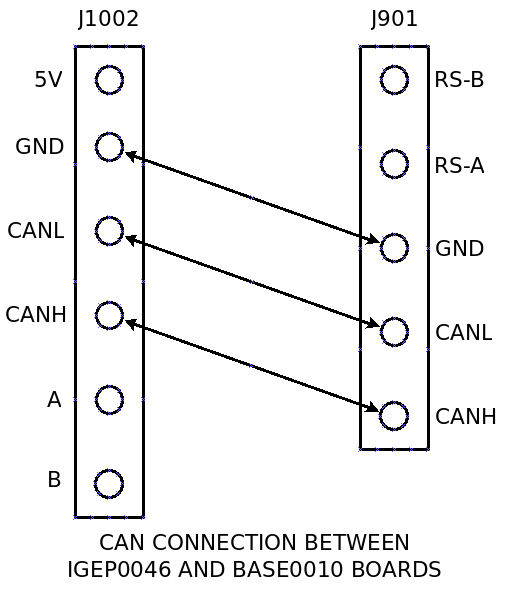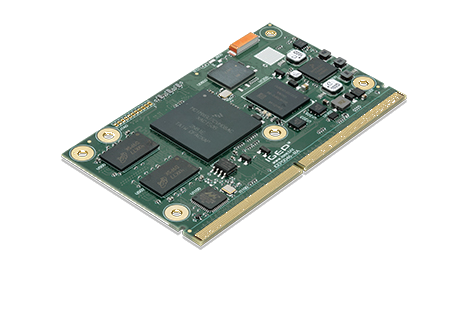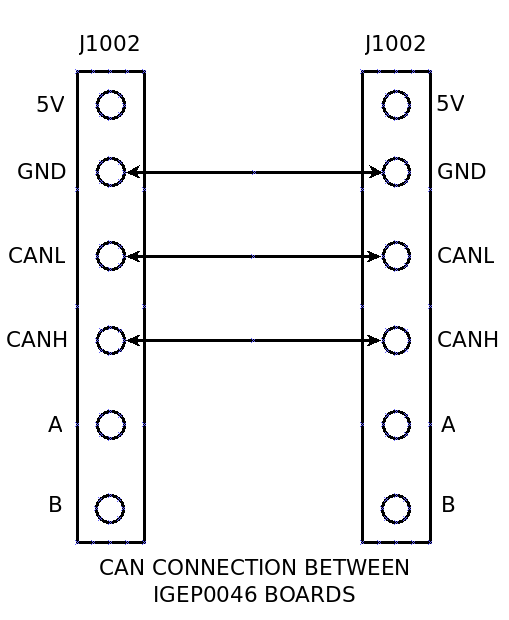Difference between revisions of "What can I do with IGEP SMARC iMX6"
From IGEP - ISEE Wiki
m (→Install firmware in eMMC) |
|||
| Line 121: | Line 121: | ||
Then you can easily play a *.wav sound with the application Aplay, for example: | Then you can easily play a *.wav sound with the application Aplay, for example: | ||
| − | $ aplay | + | $ aplay /usr/share/sounds/alsa/Side_Left.wav |
== Get sound in (audio in) == | == Get sound in (audio in) == | ||
| Line 358: | Line 358: | ||
Then you can easily play a *.wav sound with the application Aplay, for example: | Then you can easily play a *.wav sound with the application Aplay, for example: | ||
| − | $ aplay -D plughw:1,0 | + | $ aplay -D plughw:1,0 /usr/share/sounds/alsa/Side_Left.wav |
== Secondary HDMI (DVI connector on J501) == | == Secondary HDMI (DVI connector on J501) == | ||
Revision as of 13:19, 1 August 2016
| |
| |||||||||
Overview
This is the 2/3 chapter of the Getting Started with IGEP SMARC iMX6 Tutorial Guide.
In this second chapter, we will learn some basics tasks. Upon completion, you will be ready to continue with chapter 3/3 that explains more advanced tasks.
Contents
[hide]- 1 Overview
- 2 What can I do
- 2.1 Handle the GPIO-LEDS
- 2.2 How to use S1200 pushbutton
- 2.3 How to use UART (RS485)
- 2.4 CAN BUS
- 2.5 Get sound out (audio out)
- 2.6 Get sound in (audio in)
- 2.7 Get microphone in (audio in)
- 2.8 Install firmware in eMMC
- 2.9 Boot from SATA
- 2.10 Boot from eMMC
- 2.11 How to use EEPROM
- 2.12 How to use SPI NOR
- 2.13 IO expansion
- 2.14 Wifi
- 2.15 HDMI resolution
- 2.16 HDMI audio
- 2.17 Secondary HDMI (DVI connector on J501)
- 2.18 Modem USB
What can I do
You must logged in the board.
Handle the GPIO-LEDS
The board has two user bicolor (green/red) leds available that can be controlled. In its simplest form, you can control of LEDs from userspace. LEDs appear in /sys/class/leds and you can turn on and off with following commands:
echo 1 > /sys/class/leds/igep\:red\:led1/brightness echo 1 > /sys/class/leds/igep\:red\:led0/brightness echo 0 > /sys/class/leds/igep\:red\:led1/brightness echo 0 > /sys/class/leds/igep\:red\:led0/brightness
echo 1 > /sys/class/leds/igep\:green\:led1/brightness echo 1 > /sys/class/leds/igep\:green\:led0/brightness echo 0 > /sys/class/leds/igep\:green\:led1/brightness echo 0 > /sys/class/leds/igep\:green\:led0/brightness
If you want to trigger the leds you can enable this mode and select the trigger source (none by default) to: mmc0, mmc1, timer, heartbeat and default-on.
To enable any of this modes you just have to change a parameter in the directory of the led you want to control. You can see all the possibilities using the instruction 'cat':
cat /sys/class/leds/igep\:red\:led0/trigger [none] mmc0 mmc1 timer heartbeat default-on
In the example above, we have checked the status of the trigger in led red\led0. Mode 'none' is selected.
To change it, for example, to the timer mode you can use 'echo':
echo timer > /sys/class/leds/igep\:red\:led0/trigger
In this case, we have set the trigger to the 'timer' mode. Now you can set the time for what the led is ON and the time it is OFF using:
echo 250 > /sys/class/leds/igep\:red\:led0/delay_on echo 750 > /sys/class/leds/igep\:red\:led0/delay_off
Now the selected led is configured with a timer consisting of 250 miliseconds ON and 750 miliseconds OFF.
The base has two user (red/blue) leds available that can be controlled. Can't use them in the same time. In its simplest form, you can control of LEDs from userspace. LEDs appear in /sys/class/leds/base and you can turn on and off with following commands:
echo 1 > /sys/class/leds/base\:blue\:led0/brightness echo 1 > /sys/class/leds/base\:red\:led0/brightness echo 0 > /sys/class/leds/base\:blue\:led0/brightness echo 0 > /sys/class/leds/base\:red\:led0/brightness
How to use S1200 pushbutton
The board has one pushbutton. You can see with following commands:
cd /dev/input cat event0
Next step: push the button.
How to use UART (RS485)
under construction
CAN BUS
To be able to communicate the board via CAN bus, we will use can0 interface and the J1002 connector. We can communicate with another IGEP0046 or an IGEP0030 (via J9001 in IGEP BERLIN), but also with a wide variety of CAN sensors and devices. In this example, we use an IGEP0046 and an IGEP0030 on a BASE0010 IGEP BERLIN. The connections are as depicted below:

- We must, first of all, set the interface up in each device. We can do it with ip commands:
ip link set can0 up type can bitrate 125000
Where can0 is the interface we will use
- Then we must choose who will send data and who will receive it; for the one to receive we will use the following line:
candump can0
Where can0 is the interface we will use
- For the one to send CAN data, we will use the following command:
cansend can0 -i 0x123 0xaa 0xbb 0xcc 0xdd
Where can0 is the interface we will use, -i 0x123 is used to identify the device as 0x123, and 0xaa 0xbb 0xcc 0xdd, the data to be sent.
- We should get this in the CAN receiver:
<0x123> [4] aa bb cc dd
- To stop receiving data, press Ctrl+C in the listening device.
Get sound out (audio out)
Connect an external output audio device to the 3.5mm jack Audio Out connector in the board, such as external stereo powered speakers.
The amplifiers for the headset output are disabled by default, so the first thing you'll do is enable these amplifiers with:
$ amixer set -D hw:0 'PCM' 0dB $ amixer set -D hw:0 'HP DAC' 0dB
Then you can easily play a *.wav sound with the application Aplay, for example:
$ aplay /usr/share/sounds/alsa/Side_Left.wav
Get sound in (audio in)
External Audio input devices, such as a powered microphone or the audio output of a PC or MP3 player, can be connected to the via a 3.5mm jack (Audio IN).
You can record audio in with the application arecord, for example:
arecord -t wav -c 2 -r 44100 -f S16_LE -v audio-in.wav
Following output is expected on console:
Recording WAVE 'audio-in.wav' : Signed 16 bit Little Endian, Rate 44100 Hz, Stereo Plug PCM: Direct Snoop PCM Its setup is: stream : CAPTURE access : RW_INTERLEAVED format : S16_LE subformat : STD channels : 2 rate : 44100 exact rate : 44100 (44100/1) msbits : 16 buffer_size : 15876 period_size : 1764 period_time : 40000 tstamp_mode : NONE period_step : 1 avail_min : 1764 period_event : 0 start_threshold : 1 stop_threshold : 15876 silence_threshold: 0 silence_size : 0 boundary : 2080899072
When ever you think you want to stop recording just press CTRL+C
Get microphone in (audio in)
Connect an external microphone in the MIC-N connector.
Enable for the input microphone:
$ amixer -c 0 sset 'Right PGA Mixer Mic3R' on $ amixer -c 0 sset 'Left PGA Mixer Mic3L' on $ amixer -c 0 sset 'Right PGA Mixer Line1R' off $ amixer -c 0 sset 'Left PGA Mixer Line1L' off
You can record microphone in with the application arecord, for example:
$ arecord -t wav -c 2 -r 44100 -f S16_LE -v audio-in.wav
When ever you think you want to stop recording just press CTRL+C
Install firmware in eMMC
In order to access the eMMC and be capable of flashing it, we can make use of igep-flash script:
- Launch the script from terminal specifying the image you want to flash in eMMC. The script itself searches for the device to flash, so no more parameters are needed:
igep-flash --image /opt/firmware/isee-image-dev-imx6*-igep0046.tar* --skip-nandtest
Where /opt/firmware/isee-image-dev-imx6*-igep0046.tar* is the image you want to flash (in this case, the one supplied from ISEE with the official firmware), and --skip-nandtest is an option to skip checking for bad blocks (this accelerates the process, and it's optional if you don't mind bad blocks on eMMC)
- LEDs near U1200 should flash in orange while the eMMC is being written. They will flash in green when process successfully finishes.
- We can also use the UMS (U-boot Mass Storage gadget).
- Plug a microUSB to USB cable from J602 USB OTG connector to your computer. Boot the board from the microSD card and abort autoboot pressing a key when U-boot is waiting before loading the kernel. Then, start UMS with the following command:
ums 0 mmc 1
Where 0 is the USB device number 0 (USB OTG, in this case), mmc is the kind of storage device to be read (mmc or sata), and 1 is the storage device number, in this case mmc1 (onboard eMMC).
- If correctly done, U-boot should print something similar to the next line, and a mass storage device should appear in your computer.
UMS: disk start sector: 0x0, count: 0xe90000
- You can now backup its contents, as well as format it, make partitions, or use igep-media-create to flash it with an image; all straight from the computer.
- To stop UMS, press Ctrl+C and the mass storage device in your computer should disappear.
Boot from SATA
As specified in SMARC the booting device can be chosen by a combination of jumpers. To boot from carrier SATA, a SATA disk must be present in J1103 mSATA connector, and no jumpers should be connected in J1202, leaving BOOT0, BOOT1 and BOOT2 pulled down to GND. For more information, refer to SMARC Hardware Specification Guide.
Boot from eMMC
As specified in SMARC the booting device can be chosen by a combination of jumpers. To boot from module eMMC Flash, jumpers should be connected to BOOT1 and BOOT2 in J1202, leaving BOOT0 pulled down to GND. For more information, refer to SMARC Hardware Specification Guide.
How to use EEPROM
EEPROM can be read and write via /sys/devices/soc0/soc.0/2100000.aips-bus/21a8000.i2c/i2c-2/2-0050/eeprom:
- Write EEPROM:
echo "data" > /sys/devices/soc0/soc.0/2100000.aips-bus/21a8000.i2c/i2c-2/2-0050/eeprom
- Read EEPROM:
cat /sys/devices/soc0/soc.0/2100000.aips-bus/21a8000.i2c/i2c-2/2-0050/eeprom
- Following output is expected on console:
data
- EEPROM is where UBoot environment variables are stored, so if you see something else than what you wrote, it's part of those variables.
When ever you think you want to stop recording just press CTRL+C
How to use SPI NOR
Can be read and write files into SPI NOR:
- Create a directory:
mkdir Documents
- Create a file in the directory:
cd Documents/
- Write something in the file:
echo "data" > prova
- Write the file into SPI NOR:
mtd_debug write /dev/mtd0 0 1 ./Documents/prova
- Read the file:
mtd_debug read /dev/mtd0 0 1 prova
IO expansion
under construction
Wifi
In this example, we will connect to an Access Point.
- First of all, we must disable Soft Blocking on the wlan0 interface via rfkill:
rfkill unblock 0
- Then we can set the interface up:
ifconfig wlan0 up
- We can scan for Access Points if we don't know its exact SSID:
iw wlan0 scan
- Then we proceed to connect to our Access Point:
- In case our Access Point is WPA secured, we can use wpa_supplicant to connect. For this purpose, we should configure /etc/wpa_supplicant.conf file:
network={
ssid="IGEP_example"
proto=WPA2
key_mgmt=WPA-PSK
psk="password"
}
- To start the supplicant, we specify the interface, the configuration file and the driver to be used. In this case:
wpa_supplicant -Dnl80211 -i wlan0 -c wpa_supplicant.conf
- On the other hand, if it is a WEP secured Access Point, you must enter the next command. If your AP doesn't have a password, omit the key part:
iw wlan0 connect IGEP_example key 0:12345
- Then you can configure your device as you would normally do.
- After a few seconds, the link should be established. We can now check the connection pinging a known server, for example:
ping www.google.com
- If you want to set an Access Point up with the Wilink8 chip, you should use hostapd.
hostapd /etc/hostapd.conf &
- After some seconds, the Access Point should be up and working. Its SSID is "test" if using the official firmware. You can now connect to the board via wifi without the need of an external AP or network.
HDMI resolution
In order to configure HDMI resolution, we must pass the correct parameters to the kernel using UBoot.
- Stop autoboot by pressing a key when prompted to access terminal and type:
printenv
- Then change hdmi resolution by changing video_args_hdmi:
setenv video_args_hdmi setenv video_args $video_args video=mxcfb${fb}:dev=hdmi,1920x1080M@60,if=RGB24
Where 1920 is horizontal resolution in pixels, 1080 is vertical resolution in pixels, and 60 is the refresh rate in Hz.
- In userspace, you can check available resolutions:
cat /sys/devices/soc0/fb.19/graphics/fb0/modes
- You can also show current resolution:
fbset
Which would return something like this:
mode "1280x720-60"
# D: 74.250 MHz, H: 45.000 kHz, V: 60.000 Hz
geometry 1280 720 1280 720 16
timings 13468 220 110 20 5 40 5
hsync high
vsync high
rgba 5/11,6/5,5/0,0/0
endmode
- Supported iMX6 resolutions are:
| Resolution | Refresh Rate |
| 1920x1080p | 60 Hz |
| 50 Hz | |
| 30 Hz | |
| 25 Hz | |
| 24 Hz | |
| 1440x576p | 50 Hz |
| 1440x480p | 60 Hz |
| 1440x288p | 50 Hz |
| 1440x240p | 60 Hz |
| 1280x720p | 120 Hz |
| 100 Hz | |
| 60 Hz | |
| 50 Hz | |
| 720x576p | 50 Hz |
| 720x480p | 60 Hz |
| 640x480p | 60 Hz |
| 59 Hz |
HDMI audio
Connect the HDMI connector to a monitor with speakers.
Then you can easily play a *.wav sound with the application Aplay, for example:
$ aplay -D plughw:1,0 /usr/share/sounds/alsa/Side_Left.wav
Secondary HDMI (DVI connector on J501)
under construction
Modem USB
- In order to connect to the GSM network, you need to connect a modem in the J1100 connector and insert a SIM card in J1102. Then, when powering up the board, kernel should recognise the modem and list it under /dev/ as a list of ttyUSB devices. We are using a Quectel UC20 Modem, in this case.
- From userspace, we must use a serial console to communicate with the modem via AT commands:
microcom -s 115200 /dev/ttyUSB2
- Once the serial console is set, we can interact with the modem. In this example, we check the modem status, ask if the SIM card is activated or needs a pin code to be entered, enter the pin number and check signal level:
AT OK AT+CPIN? +CPIN: SIM PIN OK AT+CPIN=1234 OK +CPIN: READY +QUSIM: 1 +QIND: SMS DONE +QIND: PB DONE AT+CSQ +CSQ: 99,99 OK
Where 1234 is your SIM card's pin number.
- +CSQ: 99,99 denotes an undetectable signal. If we use an antenna, we can get better coverage. Here you can find a table with the relationship between CSQ value and dBm, as well as a guide to recognise how strong a signal level is.
- You can find more Quectel UC20 compatible AT commands here.
You have successfully completed this chapter of the guide.
| |

|
If you have any question, don't ask to ask at the IGEP Community Forum or the IGEP Community Chat | 
|




